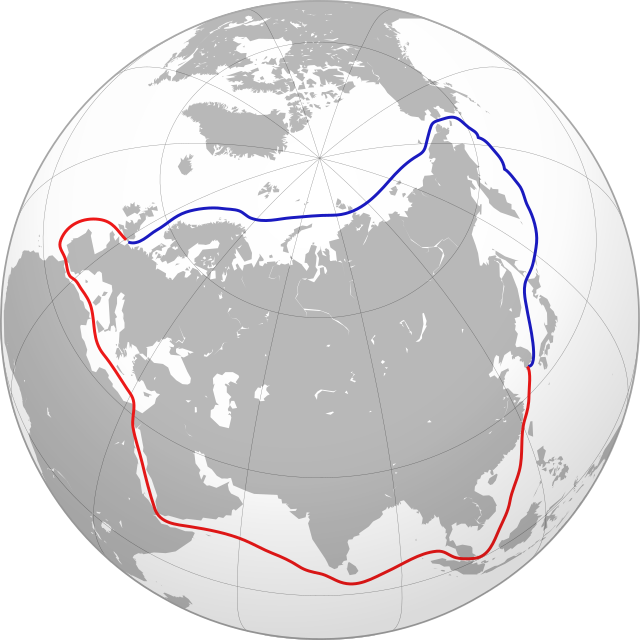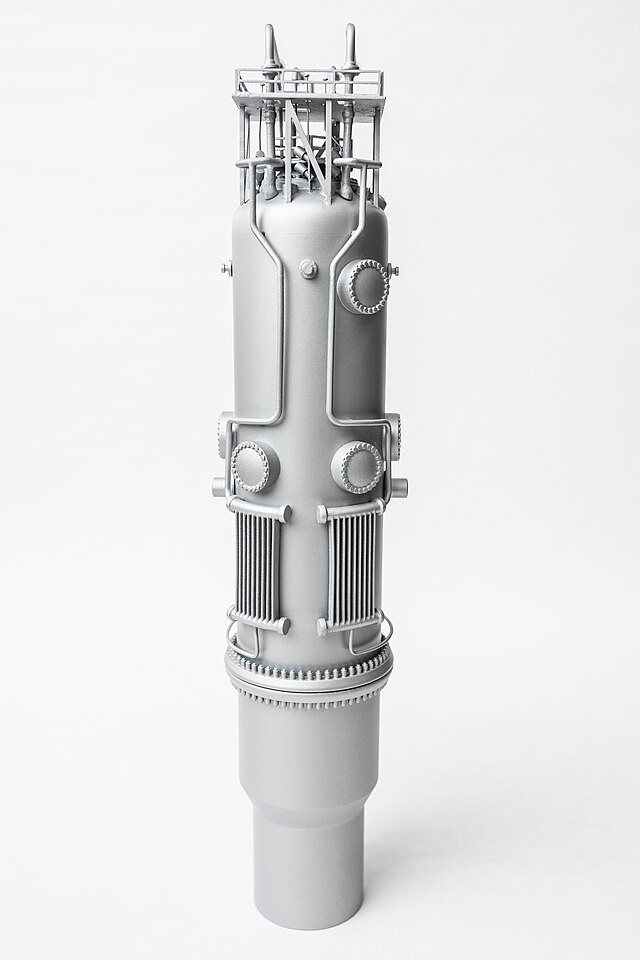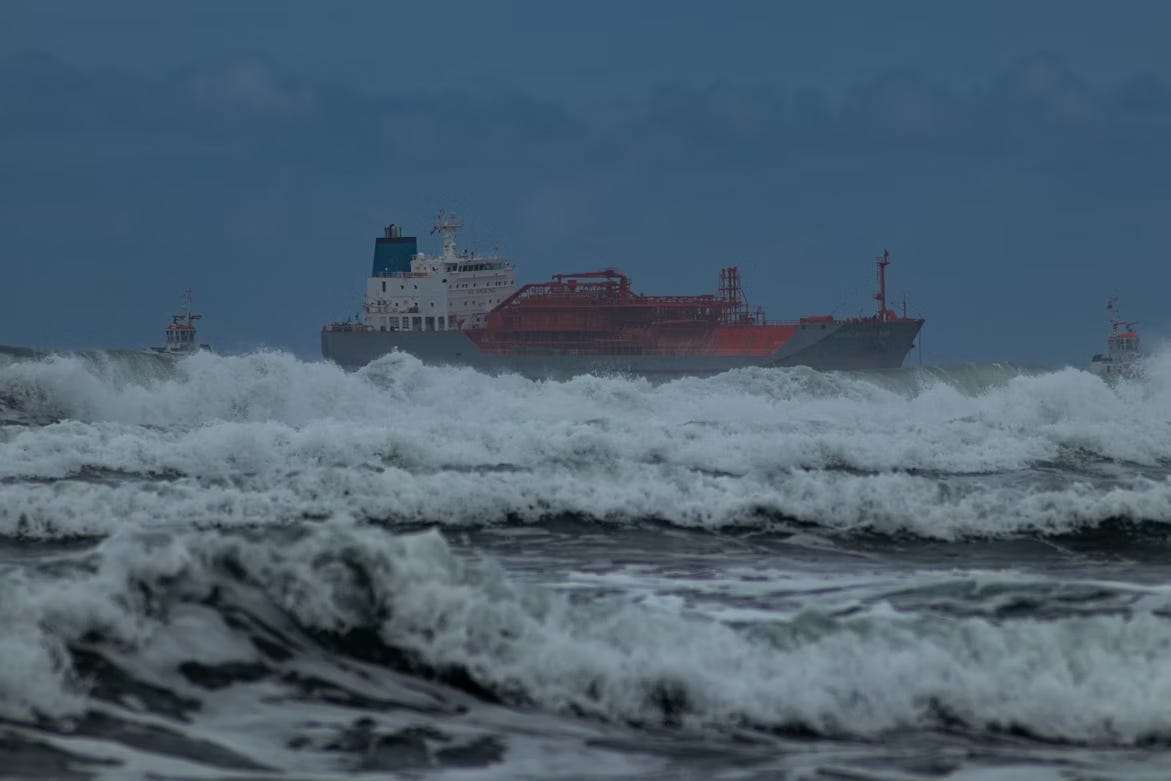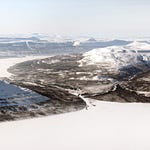
A fleet that already sails
Every few months, glossy renderings of nuclear-powered cargo ships surface in Western media. Organizations like the International Maritime Organization, Lloyd’s Register and Core Power are actively imagining a nuclear powered maritime future.
In their materials sleek “advanced” molten salt or heat pipe reactors hum silently below deck, propelling freighters across calm blue oceans without a whiff of carbon.
But in the frozen Arctic, civilian nuclear-powered ships already exist, eight and counting, and they have for nearly seventy years. They’re not hypothetical or experimental; they’re routine. And they’re not built in Silicon Valley, but in Russia.
My guest on this episode, Aleksey Rezvoi, has lived this history. A graduate of the Leningrad Shipbuilding University who worked on third- and fourth-generation submarine and icebreaker reactors at the Aleksandrov Scientific Research Technological Institute in the Soviet Union. He later emigrated to the United States working broadly throughout the nuclear sector in Idaho and Sandia National Labs, the operating civilian nuclear fleet and even the start-up world which gives him an interesting vantage point on Western nuclear discourse.
In a conversation that veered from Arctic logistics to “maritime conditions of operation” to advanced nuclear fuels, we explored what Western commentators miss when they talk about “maritime nuclear” and we highlighted the world’s only existing SMR, the RITM-200 reactor, the latest evolution of the Russian icebreaker reactor now being deployed on power barges and on land.
The Arctic problem that demanded nuclear solutions
“Look at a map of Russia,” Rezvoi began. “Most of it touches the Arctic Ocean. The oil, the gas, the minerals — they’re all up there. You can’t build an economy on those resources without a shipping window longer than a couple of months per year. And you can’t have that without nuclear.”
The Soviet Union confronted that problem in the 1950s. Its first nuclear icebreaker, Lenin, launched in 1957 and entered service in 1959 with three pressurized-water reactors (OK-150s). This was not a symbolic project or a Cold-War flex, it was infrastructure. The state needed to move fuel and ore through ice.
By the 2020s, that decision has proven prescient. The Northern Sea Route between Europe and Asia is now viable for 6 months of the year. A Chinese container ship recently completed the voyage in 20 days instead of 40 via Suez. Every day of transit saved halves fuel consumption, cost and emissions.
Rezvoi points out that Canada, with its diesel-dependent artic communities, faces a similar challenge. The Arctic isn’t just a frontier; it’s a proving ground for energy technologies which can grant territorial sovereignty.
From submarines to icebreakers: internal technology transfer
While the USSR did not publish its submarine reactor blueprints to the world they did share them with other Soviet design bureaus responsible for civilian maritime naval propulsion — especially OKBM Afrikantov.
That’s how the Soviet Union’s first Icebreaker, the Lenin, could sail in 1959 with naval-style PWRs only a few years after the USSR launched its first nuclear submarines. The United States, by contrast, locked its naval know-how inside Admiral Rickover’s program, quarantined from the commercial sector with the possible exception of Atoms for Peace symbolism in the form of the nuclear cargo ship the N.S. Savannah. Soviet engineers were not bound by that firewall and that is why the Soviet, and later Russian, maritime nuclear line has been continuous for seven decades.
From the OK-150s of Lenin to the OK-900s that replaced them in the 1960s, through the KLT-40 reactors on the next generation of icebreakers, and ultimately to today’s RITM series, one can trace a single, uninterrupted evolutionary line.
Each generation of Russian maritime reactor integrated lessons from the one before.
Generation I – OK-150: loop-type submarine derivatives, overbuilt but serviceable.
Generation II – OK-900: simplified semi-block designs, still large but more maintainable.
Generation III – KLT-40: fully modular block systems, powering vessels like Arktika and later the Akademik Lomonosov floating nuclear plant.
Generation IV – RITM-200/400: compact, integral, factory-built PWRs designed for serial production across platforms.
Across those fleets, Russia has accumulated roughly 400 reactor-years of operating experience, an industrial memory no Western SMR vendor can claim.
RITM: The World’s Only Existing SMR
The RITM series is the only reactor line that truly meets the definition of a small modular reactor, not in theory, but in practice.
Small: Each unit produces about 175 MW thermal (50–60 MW electric), two per Project 22220 icebreaker.
Modular: The nuclear steam supply system: reactor vessel, steam generators, and pumps, is integrated into a compact module, installed in pairs on ships, floating plants, or land-based stations.
Standardized: A single design platform underpins marine, barge, and terrestrial variants (RITM-200, 200S, 200N, 400), creating a consistent fleet and supply chain.
Factory-fabricated: Designed by OKBM Afrikantov and built in series by Rosatom’s Atomenergomash (ZiO-Podolsk, Izhorskiye Zavody), each reactor is assembled, tested, and shipped to the Baltic Shipyard for integration.
The result is the world’s only serially produced SMR, directly descended from Russia’s icebreaker reactors and now installed at a pace of several units per year, while Western designs struggle to get off of the drawing board.
Integral by necessity, not by marketing
Most Western audiences first encountered the phrase “integral pressurized water reactor” through NuScale’s promotional materials. The company implied it was pioneering a novel architecture. The first integral PWR designs were published in America in 1961 by Babcock and Wilcox for Germany’s Otto Hahn nuclear cargo ship. Russia just built them and kept building.
An integral PWR places the core, steam generator, and pressurizer inside a single pressure vessel. That minimizes penetrations and shortens coolant paths, allowing natural circulation cooling if pumps fail.
By contrast, NuScale’s land reactor retains an enormous steam generator with roughly 1,500 tubes and extensive welding. “It’s a skyscraper,” Rezvoi said, meaning absurdly tall and top-heavy. “You can’t put that on a barge or ship without stability problems.”
The RITM, roughly three to four times shorter, was drawn for the constraints of a hull from the outset. Its straight-pipe once through steam generator cassettes minimizes pressure loss; its naval-grade fuel maintains low internal gas pressure at high burnup.
Two safety philosophies: vent or contain
Rezvoi divides reactor safety cultures into two civilizational schools.
The Western school assumes venting. When pressure rises, relief valves open and steam dumps to containment pools. That’s manageable on land but introduces dozens of failure paths.
The Russian maritime school assumes containment. The vessel stays sealed. Heat travels via natural circulation to a passive external heat exchanger. No venting, no depressurization, minimal pipework.
“It’s the difference between adding systems and removing weak points,” he told me. In the Arctic, with no outside support, simplicity equals safety.
Designing for the sea
Western SMR developers often talk about “nuclear ships” as if the ocean were a flat, motionless floor. In reality, vessels roll 40 degrees, slam into waves, and occasionally capsize. A reactor must function through all of it.
Rezvoi’s research focuses on what he calls Maritime Conditions of Operation, a catalog of everything that can go wrong: sloshing coolant, asymmetric flooding, control rods that must still insert when inverted, hull deformation after impact.
He once asked a Western design team what their control rods would do if the ship flipped. “They said, ‘We don’t think about that.’”
In Russia, they have to think about it. Icebreakers operate through storms, collisions, and grounding hazards. The design philosophy assumes failure as normal and builds resilience from the hull up.
Fuel: a hidden differentiator
Aleksey’s most passionate digression came when we discussed fuel — the least glamorous but most decisive variable in small reactor economics.
Early Western SMR efforts, like NuScale’s, assumed that using standard uranium dioxide (UO₂) fuel would make their reactors cheaper. Rezvoi warned them two decades ago that it could cause problems. “The core is small, so the peaking factor is high,” he explained. “That means local heat fluxes are higher, gas pressure inside the pins is higher, and you have to refuel more often. Your fuel cycle becomes challenging.”
Russian maritime SMR designers solved this problem long ago with metallic fuel compositions — uranium-aluminum-silicon alloys and high-conductivity matrices — which lower internal temperatures and gas buildup. The result: higher burnup, longer core life, and fewer refueling outages. This was the philosophy behind both the naval fuels of the 1970s and the modern RITM line.
In the United States, a similar approach underlies Lightbridge, a company founded by two Russian émigré engineers who once worked on Soviet naval fuels. Their twisted-rod metallic fuel aims to replicate the same thermal advantages for Western PWRs. “They are trying to clone what we already used forty years ago,” Rezvoi said.
The ecosystem gap
Behind every functioning nuclear program stands an ecosystem, not the anemic staff of a small startup.
In Russia, one of those ecosystems is Afrikantov OKBM in Nizhny Novgorod. It consists of several thousand engineers, metallurgists, and machinists working in one complex. They design naval propulsion systems, floating plants, and now land-based SMRs, all from a shared data backbone. The same test loops and materials labs serve multiple generations of designers.
In contrast Rezvoi describes a team building activity at an American startup he attended. He asked forty-five engineers in the room who had ever seen an operating reactor. One hand went up. “That’s the difference,” he said. “In Russia, everyone has.”
If you add up all the personnel across Western micro-reactor startups, you might reach the headcount of one Russian design bureau — but scattered across 30 firms with no shared test infrastructure. Modeling and simulation have replaced apprenticeship and tactile feedback. Russia’s unbroken line of production preserved those instincts. An engineer can still walk down the hall and ask a colleague who commissioned an earlier unit.
The irony is that the RITM embodies everything Western policymakers say they want: modularity, standardization, and flexible deployment. But it emerged from a state-directed industrial system, not a venture-capital ecosystem.
Technology readiness versus imagination
For Rezvoi, most “advanced reactor” hype is a misreading of readiness. “Molten salts, sodium fast, heat pipes, they sound great on PowerPoint. But they don’t have real test data, fuel cycles, or maintenance infrastructure. Light water is the only system with enough maturity to build now.”
After 400 reactor-years of operation, Russia keeps refining the same light-water based maritime reactor because it works. Every new material or geometry is tested against known failure modes. The West, by contrast, keeps betting that conceptual novelty will outrun physical reality.
Final reflections
Those interested in the promise of maritime nuclear power should think less about futuristic breakthroughs and spend more time studying the history and current developments within the worlds only civilian maritime industry.
Through geographical and national necessity the Soviet Union and later Russia created a living, evolving reactor family that now spans icebreakers, barges, and land installations and is the key to opening up the 21st centuries most important emerging transporation corridor, the Northern Sea Route.
The most recent in that series, the RITM, remains the only serially produced SMR in the world: a compact, integral light-water design building off of 400 reactor-years of accumulated experience in its predecessors.
If the West truly wants a nuclear maritime shipping revolution, it might start by studying the one that has already happened and is gaining steam fast
If you appreciate long-form, empirically grounded analysis that separates hardware from hype, support Decouple Media on Substack.
Share this story with someone who still believes the first SMR hasn’t been built yet.
.













